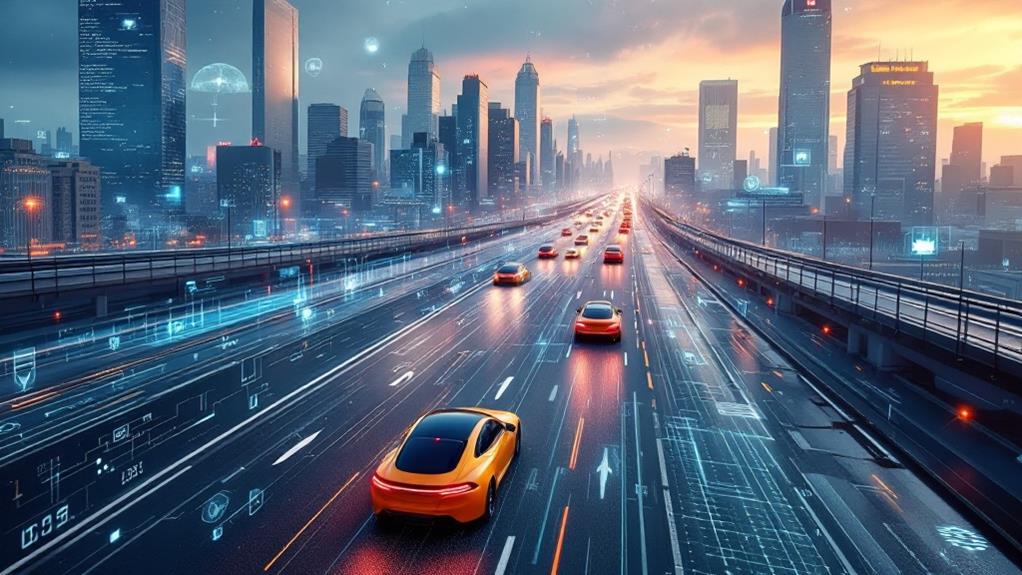How Do Self-Driving Cars Work? The Science Behind Autonomous Vehicles

You might wonder how self-driving cars operate so smoothly. They use a mix of cutting-edge technologies like lidar, cameras, and radar to map their environment. Each sensor has its role, from detecting obstacles to identifying lane markings. These sensors feed information into the vehicle's AI, which processes data, enabling the car to make real-time decisions like accelerating or braking. Communication systems keep them connected with other vehicles and infrastructure for better traffic flow. An added layer of safety protocols guarantees the right responses in emergencies. As you uncover more, you'll gain deeper insights into this evolving technology.
Key Components of Autonomous Vehicles
Autonomous vehicles, or self-driving cars, rely on several key components to operate safely and efficiently. One significant element is navigation systems, which guide the vehicle accurately by determining its position, planning routes, and adapting to road conditions. You'll find that advanced mapping technologies work hand-in-hand with these systems, providing high-definition maps that help the car understand its environment and make informed decisions on the road.
Vehicle communication is another fundamental component, allowing self-driving cars to interact with other vehicles and infrastructure. This real-time exchange of information improves traffic flow, reduces congestion, and increases general safety. Speaking of safety, robust safety protocols guarantee that autonomous vehicles respond correctly in emergencies, protecting both passengers and pedestrians.
Power management plays an important role in the functionality of self-driving cars. Efficient power management systems guarantee that the vehicle's energy resources are used effectively, extending range and improving performance. Ultimately, regulatory frameworks guide the development and deployment of autonomous vehicles, making sure they meet legal standards and public safety requirements. By understanding these key components, you'll appreciate how self-driving cars are transforming transportation and paving the way for a safer, more efficient future on the roads.
Sensor Technologies and Their Functions
While understanding the key components of self-driving cars, you can't overlook the vital role sensor technologies play. These sensors enable vehicles to perceive their surroundings, making autonomous navigation possible. Each sensor serves a unique function, and together, they create an all-encompassing view of the environment through sensor fusion.
- Lidar Technology: Lidar uses lasers to measure distances to objects by bouncing light off surfaces. It creates detailed 3D maps of the vehicle's surroundings, allowing for precise obstacle detection and navigation.
- Camera Systems: Cameras capture visual information, much like the human eye. They help the car identify objects, lane markings, traffic signals, and road signs in real-time. This is essential for making informed decisions on the road.
- Ultrasonic Sensors: These sensors detect objects in close proximity to the car, typically for parking assistance. They emit sound waves and measure the time it takes for the echoes to return, identifying nearby objects.
- Radar Applications: Radar uses radio waves to determine the speed and distance of objects. It's particularly effective in detecting other vehicles and tracking their movement, especially in adverse weather conditions.
Role of Artificial Intelligence

In the domain of self-driving cars, artificial intelligence (AI) is the brain behind the operation. It uses machine learning to analyze vast amounts of data, enabling the vehicle to perceive its surroundings accurately. This is where computer vision comes into play, allowing the car to interpret visual data from cameras and sensors, much like how you use your eyes to navigate the world. AI processes this information to identify obstacles, traffic signs, and lane markings.
Safety protocols are embedded into the AI systems to guarantee that the car operates securely. These protocols are pivotal for user acceptance, as people need to trust that autonomous vehicles can protect them on the road. However, it's not just about safety; ethical considerations also play a significant role. AI must make decisions that prioritize human life and minimize harm, which can be quite complex.
Regulatory frameworks are fundamental in shaping how AI is implemented in self-driving cars. They assure that these vehicles adhere to legal and safety standards, facilitating broader user acceptance. By understanding AI's role in autonomous vehicles, you can appreciate its transformative impact on transportation.
Data Processing and Decision Making
In regard to self-driving cars, data processing and decision-making are crucial for their operation. These vehicles rely on a complex network of sensors and cameras to gather information about their surroundings. To make sense of this data, a process called data fusion combines inputs from diverse sources, creating an all-encompassing understanding of the environment. Once this data is fused, the self-driving car's system uses algorithm optimization to guarantee quick and accurate decision-making. This means the car can adapt to changing conditions and make real-time decisions, like stopping for pedestrians or changing lanes safely.
To give you a clearer picture, here's how data processing and decision-making work:
- Data Collection: The car collects data from sensors like LiDAR, radar, and cameras.
- Data Fusion: Information from all these sensors is merged to create a unified understanding of the car's surroundings.
- Algorithm Optimization: Algorithms are fine-tuned to optimize the car's responses to different traffic scenarios.
- Decision Execution: The car executes decisions, such as accelerating, braking, or steering, based on processed data.
Challenges and Future Developments

Self-driving cars have made impressive strides in data processing and decision-making, yet they still face significant obstacles. One major challenge is regulatory hurdles. You see, governments worldwide are grappling with how to create laws that guarantee safety without stifling innovation. Maneuvering through these legal landscapes can be a maze for developers aiming to bring autonomous vehicles to market.
Public perception also plays an essential role. People might feel uneasy about relinquishing control to a machine, and any high-profile accidents can amplify these concerns. Building trust in technology is vital, and it requires ongoing education and transparency from companies involved.
Ethical dilemmas are another hurdle. Imagine a scenario where a self-driving car must choose between two harmful outcomes. How do you program morality into an algorithm? These questions need addressing before widespread adoption.


